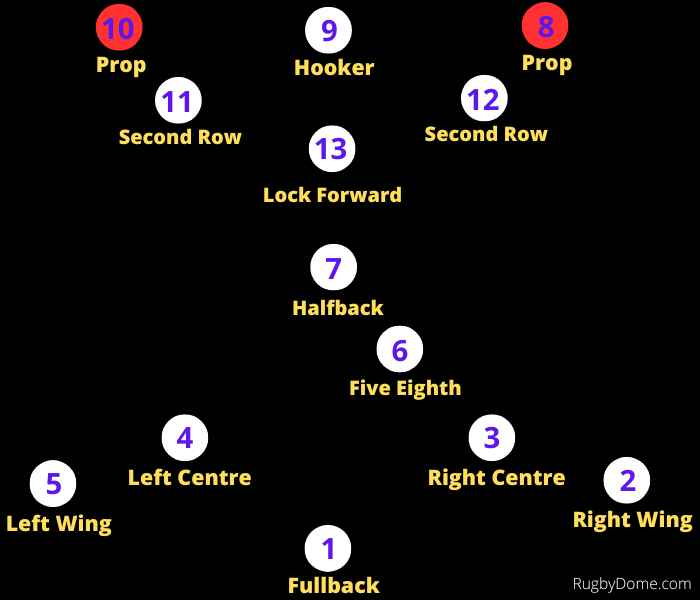There are two props in a rugby league team. They are part of the six forwards on the team.
Props traditionally wear the number eight and number ten jersey. This article looks at the crucial role of rugby league props in attack and defence.
We have a separate article on the role of props in rugby union.
Positioning
Although scrums aren’t a big part of modern rugby league, they are still used to restart play in various scenarios. Both props are positioned in the front row of the scrum.
The number eight lines up on the left of the hooker and the number ten is on the right. They are also known as loosehead and tighthead respectively. This picture shows the alignment.

What Do Props Do In Attack?
Props have three primary roles in attack:
- Ball-carrying
- Efficient play-the-ball
- Support and decoy runs
Props As Ball-Carriers
When a player is tackled, the dummy half (usually the hooker) picks up the ball and passes it to keep play going.
Props are often the first or second receivers of the ball from the dummy half. Their role is to make strong, direct runs at the opposition’s defensive line. This is often called a “hit-up”.
Props use their size and strength to drive defenders back in the tackle and create momentum for their team. The best outcome for props is that they break through tackles for valuable meters.
It may seem that props are simply running straight lines into brick walls. But the best props in league use variation in their ball-carrying.
They vary their running angles and speed to keep the defenders guessing and create opportunities for breaks.
Props also love to target weaker defenders. You can almost see them licking their lips when a smaller player is lined up against them.
Fast Play-The-Ball Skills
Despite their bulk, props need to get to their feet quickly after being tackled. By playing the ball quickly and accurately, they let their team maintain the attacking tempo.
This also hinders the defense from reorganizing.
Support Play And Decoy Runs
Props run in support of their teammates to ensure they are in a position to take offloads. This means that props need te be fast as well as big.
But props are also used as decoy runners. They need to convince the defenders that they are the next receiver of the ball.
By drawing attention of the defense, the playmaker or dummy half has the opportunity to put another teammate into space.
Role Of Props In Defence
As two of the bigger players on the field, tackling is a huge part of a prop’s role. They make a significant number of tackles throughout the game.
Props are expected to stop big ball-carriers in their tracks and prevent the attacking team from gaining momentum. Excellent tackling technique is essential.
And because props make so many tackles, they must keep good technique when fatigued. Props need to be very fit.
Another important part of tackling is that props get to their feet as quickly as they can after executing the tackle. They must rejoin the defensive line to keep it aligned and connected.
Marker defense
After a tackle, the dummy half from the attacking team will play the ball. The defending team are always trying to limit the available options.
They do so by having two markers stand directly in front of the play-the-ball to prevent the half from making a direct break or exploiting gaps around the sides of ruck area.
Props often take up the position of marker.
Difference Between Number 8 And Number 10
Aside from packing down on different sides of hooker in scrums, are there other differences between the number 8 and the number 10?
Historically, when scrums were contested in league, there were crucial differences between the two prop positions. The number 8 was known as the loosehead and was expected to push more strongly than the number 10 (known as the tighthead).
But now that scrums aren’t contested, there is no real difference needed in technique or strength.
How Do Props Maintain Their Energy During A Game?
If you’ve watched a few league matches, you’ll know that props are like rather large Energizer bunnies. They seem to be constantly hitting up the ball in attack and making big-impact tackles in defense.
How do these big players keep doing this for a full game? Well, the answer is that they don’t.
Props must pace themselves and manage their exertions. For example, they may choose to make shorter, more controlled runs during the early stages of a match, saving their energy for critical moments later in the game.
They also use the time between set restarts and even between tackles to claw back some energy. If you’re close to the pitch, you’ll see them taking deep breaths.
That doesn’t mean that they’re about to keel over from exhaustion! They are trying to control their heartrate and maintain their focus.
Can Props Transition To Other Positions?
The ability to transition to different positions depends on the individual player’s skill set.
You may be surprised to hear that props are more likely to transition to the second row rather than to the hooker position in the front row.
Second rows require similar levels of strength, power, and great tackling technique as props.
However, second rows are more typically involved in passing moves. Props intending to transition will need to ensure their ball-handling skills are up to par.